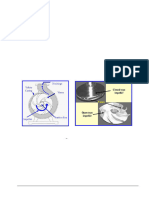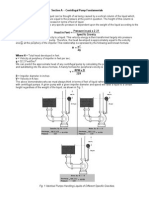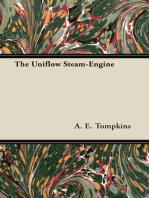Motor Size - 2
Motor Size - 2
Uploaded by
Anil JoshiCopyright:
Available Formats
Motor Size - 2
Motor Size - 2
Uploaded by
Anil JoshiOriginal Title
Copyright
Available Formats
Share this document
Did you find this document useful?
Is this content inappropriate?
Copyright:
Available Formats
Motor Size - 2
Motor Size - 2
Uploaded by
Anil JoshiCopyright:
Available Formats
Water Systems Piping
51
The general equation used to calculate WHP, also known as hydraulic horsepower (HHP), is as follows: WHP = ft of head (gal/min) specic gravity 3960 (1.63)
Assuming a pump efciency of 80 percent, the pump brake horsepower (BHP) required is BHP = 5679 = 7099 HP 0.8
The general equation for calculating the BHP of a pump is BHP = ft of head (gal/min) (specic gravity) 3960 effy (1.64)
where effy is the pump efciency expressed as a decimal value. If the pump is driven by an electric motor with a motor efciency of 95 percent, the drive motor HP required will be Motor HP = 7099 = 7473 HP 0.95
The nearest standard size motor of 8000 HP would be adequate for this application. Of course this assumes that the entire pumping requirement at the Corona pump station is handled by a single pump-motor unit. In reality, to provide for operational exibility and maintenance two or more pumps will be congured in series or parallel congurations to provide the necessary pressure at the specied ow rate. Let us assume that two pumps are congured in parallel to provide the necessary head pressure of 1219 psi (2816 ft) at the Corona pump station. Each pump will be designed for one-half the total ow rate (7986.11) or 3993 gal/min and a head pressure of 2816 ft. If the pumps selected had an efciency of 80 percent, we can calculate the BHP required for each pump as follows: BHP = 2816 3993 1.0 3960 0.80 from Eq. (1.64)
= 3550 HP Alternatively, if the pumps were congured in series instead of parallel, each pump will be designed for the full ow rate of 7986.11 gal/min but at half the total pressure required, or 1408 ft. The BHP required per pump will still be the same as determined by the preceding equation. Pumps are discussed in more detail in Sec. 1.13.
You might also like
- Section 11 EquipmentDocument18 pagesSection 11 EquipmentaistopNo ratings yet
- Heriot-Watt University: 3 Year Mechanical Engineering LaboratoryDocument7 pagesHeriot-Watt University: 3 Year Mechanical Engineering LaboratoryTom chambetNo ratings yet
- Pumps in Series and ParallelDocument6 pagesPumps in Series and ParallelSuhadahafiza Shafiee0% (1)
- How To Choose Hydraulic PumpsDocument6 pagesHow To Choose Hydraulic PumpsShridhar RaoNo ratings yet
- Chapter 5 Pump and Control Devices PDFDocument68 pagesChapter 5 Pump and Control Devices PDFRana G100% (3)
- Pumping Energy and Variable Frequency DrivesDocument4 pagesPumping Energy and Variable Frequency DrivesHerman Dwi NoviantoNo ratings yet
- Module 3 - Pump Configuration Specific Speed and Affinity Laws - No AnsDocument17 pagesModule 3 - Pump Configuration Specific Speed and Affinity Laws - No AnsRoi Vincent AnitNo ratings yet
- Pump Curve UnderstandingDocument7 pagesPump Curve UnderstandingViệt Đặng Xuân100% (1)
- Lecture Sheet 3 PDFDocument14 pagesLecture Sheet 3 PDFMuhammed RazzaqueNo ratings yet
- Liquid Handling Pumps InformationDocument15 pagesLiquid Handling Pumps InformationtowiwaNo ratings yet
- Understanding Pump Curves PDFDocument2 pagesUnderstanding Pump Curves PDFumairgul841No ratings yet
- Efficiency and Input Power of The PumpDocument14 pagesEfficiency and Input Power of The PumpMohammed BrashdiNo ratings yet
- Lab 4 - ESPDocument9 pagesLab 4 - ESPednaquansaNo ratings yet
- 6.pumps and Pumping SystemsNDocument35 pages6.pumps and Pumping SystemsNRanjani J DeepakNo ratings yet
- Week 2 Water PumpingDocument76 pagesWeek 2 Water PumpingAbdullahi Dirie AbdiNo ratings yet
- Parallel Pump OperationDocument5 pagesParallel Pump Operationarunima04100% (1)
- Pump Starup ProcedureDocument23 pagesPump Starup ProcedureKrishnan ManiNo ratings yet
- Pumps and Pumping SystemsDocument59 pagesPumps and Pumping Systemsluis_may22100% (1)
- Design and Analysis of Centrifugal PumpsDocument2 pagesDesign and Analysis of Centrifugal PumpsMTOLNo ratings yet
- Section 1.3 Hydraulic System Power RequirementDocument4 pagesSection 1.3 Hydraulic System Power Requirementaerogem618No ratings yet
- MCE 482 - Pump System Matching and Parallel and Series ConnectionDocument24 pagesMCE 482 - Pump System Matching and Parallel and Series ConnectionKhaled AlfayomyNo ratings yet
- How To Read Basic Pump CurvesDocument5 pagesHow To Read Basic Pump CurvesGaurav100% (1)
- Selection of Centrifugal Pumping EquipmentDocument11 pagesSelection of Centrifugal Pumping Equipmentshahzad32552372No ratings yet
- Vspa 50Document5 pagesVspa 50elfo111No ratings yet
- Centrifugal Pump FundamentalsDocument30 pagesCentrifugal Pump Fundamentalsdndudc100% (1)
- Centrifugal Pump (Advanced)Document9 pagesCentrifugal Pump (Advanced)Việt Đặng XuânNo ratings yet
- Pumping of LiquidsDocument13 pagesPumping of LiquidsMṜ ΛßßΛSNo ratings yet
- Title: Figure 1: Categories of Centrifugal PumpDocument7 pagesTitle: Figure 1: Categories of Centrifugal PumpHaziq Pazli100% (1)
- IrrigSmart 3241 J Pump EfficiencyDocument2 pagesIrrigSmart 3241 J Pump EfficiencyEinstein JeboneNo ratings yet
- Objective of PumpsDocument6 pagesObjective of PumpsTomide OlasupoNo ratings yet
- Theory Practical 1Document10 pagesTheory Practical 1Dilhara PinnaduwageNo ratings yet
- Pump BasicsDocument72 pagesPump BasicsVineeth Vs100% (1)
- Pump Power CalculatorDocument2 pagesPump Power CalculatorforuzzNo ratings yet
- How To Read A Pump CurveDocument6 pagesHow To Read A Pump CurvetayeloluNo ratings yet
- A Centrifugal Pump Converts The Input Power To Kinetic Energy in The Liquid by Accelerating The Liquid by A Revolving DeviceDocument6 pagesA Centrifugal Pump Converts The Input Power To Kinetic Energy in The Liquid by Accelerating The Liquid by A Revolving DeviceAudrey Patrick KallaNo ratings yet
- Liquid Horsepower Liquid Horsepower Is The Hydraulic Power Transferred To TheDocument2 pagesLiquid Horsepower Liquid Horsepower Is The Hydraulic Power Transferred To Thesanshinde10No ratings yet
- Pump CurveDocument3 pagesPump CurveUsman Ashraf100% (1)
- Reading The Pump Curve - Intro To PumpsDocument4 pagesReading The Pump Curve - Intro To PumpsVIVANo ratings yet
- Coordinating High-Volume Water Supply Operations - Fire ApparatuDocument11 pagesCoordinating High-Volume Water Supply Operations - Fire ApparatuShelkNamNo ratings yet
- Motor Application FormulasDocument1 pageMotor Application FormulasMAJIDM3000No ratings yet
- Power and TorqueDocument5 pagesPower and Torqueanappan0% (1)
- Chapter 3 PumpDocument12 pagesChapter 3 PumpChun ChinNo ratings yet
- How To Read A Pump Curve PDFDocument24 pagesHow To Read A Pump Curve PDFbennylivi100% (6)
- Hysys Liquid PumpingDocument8 pagesHysys Liquid PumpingEkundayo JohnNo ratings yet
- Introduction To Pump Curves Gould PumpsDocument24 pagesIntroduction To Pump Curves Gould PumpsAna Peña100% (1)
- Waukesha Cherry-Burrell: How To Read and Use Centrifugal Pump Curve Performance DataDocument4 pagesWaukesha Cherry-Burrell: How To Read and Use Centrifugal Pump Curve Performance DatajokishNo ratings yet
- Power and Torque - : Home About EPI Site Map Contact UsDocument6 pagesPower and Torque - : Home About EPI Site Map Contact UsTerefe TadesseNo ratings yet
- Pumping TerminologyDocument24 pagesPumping TerminologychandrasencciNo ratings yet
- Energy Conservationi N Pumps: M.V.Pande Dy - Director NPTI, NagpurDocument37 pagesEnergy Conservationi N Pumps: M.V.Pande Dy - Director NPTI, NagpurmvpngpNo ratings yet
- Discussion Pump FaizDocument2 pagesDiscussion Pump FaizFaiz Irfan RozahiNo ratings yet
- (Oto-Hui - Com) en - Hydraulic CoursesDocument47 pages(Oto-Hui - Com) en - Hydraulic Courseseng_ebrahim_2000100% (1)
- Vspa 50Document5 pagesVspa 50winarnobNo ratings yet
- Steam Power Cycles Part 1Document7 pagesSteam Power Cycles Part 1UNIQUE INDIANo ratings yet
- Pump VFD Energy Savings Calculations MethodologyDocument15 pagesPump VFD Energy Savings Calculations MethodologyRavindra Angal0% (1)
- لقطة شاشة ٢٠٢٤-٠٢-١١ في ٨.٣٨.٤٩ صDocument28 pagesلقطة شاشة ٢٠٢٤-٠٢-١١ في ٨.٣٨.٤٩ صabdollahali2004No ratings yet
- ERT 205 Lab 5Document14 pagesERT 205 Lab 5Ang Kien HauNo ratings yet
- Reading Pump CurvesDocument4 pagesReading Pump CurvesRobert Barrett100% (1)
- How to Select the Right Centrifugal Pump: A Brief Survey of Centrifugal Pump Selection Best PracticesFrom EverandHow to Select the Right Centrifugal Pump: A Brief Survey of Centrifugal Pump Selection Best PracticesRating: 5 out of 5 stars5/5 (1)
- Seawater Desalination by Reverse Osmosis (Case Study) : De!HllnationDocument7 pagesSeawater Desalination by Reverse Osmosis (Case Study) : De!HllnationAnil JoshiNo ratings yet
- Type Test ApprovalsDocument4 pagesType Test ApprovalsAnil JoshiNo ratings yet
- FR Single CoreDocument6 pagesFR Single CoreAnil JoshiNo ratings yet
- Ducab ConnectDocument172 pagesDucab ConnectAnil JoshiNo ratings yet
- 50 Chapter One: 1.12 Pumping HorsepowerDocument1 page50 Chapter One: 1.12 Pumping HorsepowerAnil JoshiNo ratings yet
































































